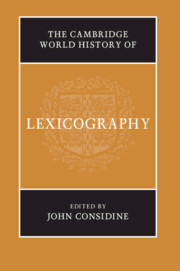Book contents
- The Cambridge World History of Lexicography
- The Cambridge World History of Lexicography
- Copyright page
- Contents
- Contributors
- Editor’s Acknowledgements
- Introduction
- Part I The Ancient World
- Part II The Pre-Modern World
- Part III The Modern World: Continuing Traditions
- Part IV The Modern World: Missionary and Subsequent Traditions
- 26 Missionary Traditions in South America
- 27 Missionary Traditions in Mesoamerica
- 28 Missionary and Subsequent Traditions in North America
- 29 Missionary Traditions in East Asia
- 30 European Traditions in India and Indonesia
- 31 Missionary and Subsequent Traditions in Africa
- 32 Missionary and Other Traditions in Australia
- Appendix 1 The Language Varieties
- Appendix 2 The Lexicographers
- Primary Sources
- Secondary Sources
- Index
32 - Missionary and Other Traditions in Australia
from Part IV - The Modern World: Missionary and Subsequent Traditions
Published online by Cambridge University Press: 01 September 2019
- The Cambridge World History of Lexicography
- The Cambridge World History of Lexicography
- Copyright page
- Contents
- Contributors
- Editor’s Acknowledgements
- Introduction
- Part I The Ancient World
- Part II The Pre-Modern World
- Part III The Modern World: Continuing Traditions
- Part IV The Modern World: Missionary and Subsequent Traditions
- 26 Missionary Traditions in South America
- 27 Missionary Traditions in Mesoamerica
- 28 Missionary and Subsequent Traditions in North America
- 29 Missionary Traditions in East Asia
- 30 European Traditions in India and Indonesia
- 31 Missionary and Subsequent Traditions in Africa
- 32 Missionary and Other Traditions in Australia
- Appendix 1 The Language Varieties
- Appendix 2 The Lexicographers
- Primary Sources
- Secondary Sources
- Index
Summary
This chapter sets out in broad brush some of the main trends in lexicographic work on the indigenous languages of mainland Australia and nearby islands – some of the major ones being Torres Strait Islands, Bathurst Island, Melville Island, Groote Eylandt, Mornington Island, and Bentinck Island – by missionaries, from the early days of contact with Europeans to the present. Prior to contact with Europeans, some 400 languages were indigenous to this region, depending on the criteria one adopts for languagehood; the twenty-first edition of Ethnologue lists just under 400 languages on an assortment of criteria, while R. M. W. Dixon recognizes around 250 languages based on the linguistic criterion of mutual intelligibility. These belong to twenty or thirty different families which have not to date been shown to be related to one another. Since European contact, a number of other languages have come to be spoken in Australia. These non-indigenous languages are excluded from the present chapter, except for a small number of post-contact varieties, mainly pidgins and creoles, that are currently spoken by indigenes of Australia.
- Type
- Chapter
- Information
- The Cambridge World History of Lexicography , pp. 682 - 705Publisher: Cambridge University PressPrint publication year: 2019

